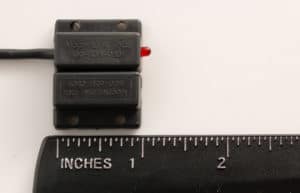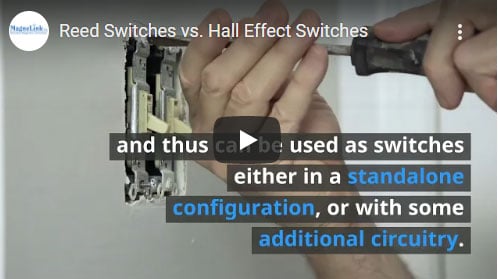Magnetic Switch Selection: Reed Switch vs. Hall Effect Switch
Reed switches and Hall Effect switches are both considered magnetic switches since their properties change when exposed to a magnetic field. Strictly speaking, however, Hall Effect switches are transducers since they convert magnetic energy to electrical energy—they can be used as switches with some additional circuitry. Reed switches are true magnetic switches since they close or open in the presence or absence of a magnetic field.
Reed and Hall Effect switches are ubiquitous not only in electronic devices like cell phones and computers, but also in electromechanical systems like automobile control circuits and fluid control systems. System designers weigh many factors before considering Reed switches and Hall Effect switches for an application.

Reed Switches
Reed switches consist of a pair of contacts enclosed in a protective glass casing. The contacts are thin, flexible reeds made of ferromagnetic materials with a small air gap separating their contact points. When there is a strong enough magnetic field parallel to the reeds to magnetize them, they flex and touch to complete a circuit for current flow.
Typically the magnetic field is generated by a permanent magnet, but a current carrying coil of wire may also be used. Unlike Hall Effect switches, Reed switches:
- Do not need anything other than the magnetic field to bring about their switching action.
- Are not sensitive to the polarity of the magnetic field.
In other words, they will operate the same way for a North-South magnetic field as well as a South-North magnetic field as long as the magnetic field is parallel to the reeds.
The hermetically sealed glass casing of a Reed switch protects it from mechanical shock and environmental factors such as dust, moisture, and corrosive gases. This makes Reed switches ideal for a wide variety of ambient conditions. Applications include:
- Reed switches are safe for use in environments with explosive gases or chemicals because any sparking from the switching action stays within the glass case and switch housing encasing the reed switch.
- They are widely used as speed sensors in bicycle wheels, car gears, and treadmills.
- Reed switches serve as proximity sensors in electronic devices with a clamshell design, detecting whether the device is open or closed—flip phones and laptop computers are examples of such devices.
- Applications that feature wide temperature ranges or harmful environmental factors.
Hall Effect Switches
 Hall Effect switches are semiconductor transducers that generate an electrical voltage when a magnetic field is present. The generated electrical voltage can be used for activating solid state switches. They require a constant flow of current to make them act as transducers.
Hall Effect switches are semiconductor transducers that generate an electrical voltage when a magnetic field is present. The generated electrical voltage can be used for activating solid state switches. They require a constant flow of current to make them act as transducers.
When a piece of Hall Effect material carrying an electric current is immersed in a magnetic field that is perpendicular to the current, several millivolts of electric potential develop in the material. The direction of the voltage is perpendicular to both the current and the magnetic field. As such, the polarity and direction of the current and magnetic field are crucial to the proper function of Hall Effect switches.
Unlike Reed switches, Hall Effect switches:
- Have no moving parts, so they are unaffected by mechanical shock.
- Do not experience wear and tear either despite ‘switching’ at a high rate, even in excess of 100 kHz.
- Can be protected from adverse environmental factors like dust and moisture through proper packaging.
For all practical purposes, Hall Effect switches have an infinite life expectancy—with no mechanical components to wear out.
Hall Effect switches are used for a variety of applications, such as:
- Measuring the rotational speed of wheels and shafts.
- Timing ignitions in internal combustion engines.
- Tachometers and anti-lock braking systems.
- Limit switches on actuators for automated controlled systems.
Since they respond accurately and quickly to rapidly fluctuating magnetic fields, they are used for sensing the location of magnets in brushless DC motors.
Magnetic Switches from Magnelink
To summarize, both Reed switches and Hall Effect switches are activated by magnetic fields—the former as a classical switch and the latter as a transducer. Reed switches do not need any additional circuitry for switching, while Hall Effect switches do. There are significant differences between the two in sensitivity, switched load capacity, and life expectancy.
Magnelink has been a supplier of reliable, high-quality magnetic switches at affordable prices for over 25 years. We specialize in providing standard and custom switches that meet our customer’s specific needs. Contact us today with your Reed switch vs. Hall Effect switch questions.

